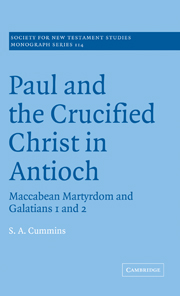Conclusion
Published online by Cambridge University Press: 22 September 2009
Summary
This monograph has attempted to forge a new interpretation of a text central to any estimation of both Pauline theology and the early Christian church. Inasmuch as this has arisen from the cumulative weight of converging lines of evidence – often novel and significant in their own right – we may conclude by briefly recapitulating the most important contributions made at each stage of our enterprise. In sum, it has been contended that:
Constitutive of the Jewish response to the epic Maccabean crisis were two key interrelated themes: (a) the suffering and vindication of the people of God, especially as focused upon certain martyr figures; and (b) emerging from this, in relation to Daniel 7.13–14, ongoing messianic speculation concerning an eschatological redeemer who would deliver and restore afflicted Israel.
The ethos and religio-political aspirations of the Maccabees remained a living tradition in first-century Judaism, fuelling Jewish–Christian conflict – not least insofar as this involved Paul, whether as a zealous Pharisee or a Jewish Christian convert.
All this is of significant bearing upon the Galatian crisis, the conceptual framework governing Paul's response thereto, and his autobiographical narrative in Galatians 1 and 2. The Galatian scenario, attended by conflict and persecution, may be perceived as an inversion of the Maccabean crisis. Paul's conceptual framework may be understood as a Jewish apocalyptic (e.g., Danielic) schema now radically reconfigured through Jesus Christ, Israel's (unexpected) eschatological redeemer.
- Type
- Chapter
- Information
- Paul and the Crucified Christ in AntiochMaccabean Martyrdom and Galatians 1 and 2, pp. 231 - 232Publisher: Cambridge University PressPrint publication year: 2001

